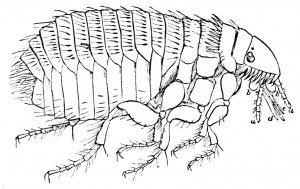Like many other parasites, fleas prefer to inhabit a very particular type of climate. Families living in regions with flea-prone climates will naturally experience larger and more frequent infestations. The right temperature and humidity creates ideal conditions for these parasites to thrive, at which point they will reproduce with their numbers spiraling out of control. You can combat fleas, however, by making the necessary changes to your home so it’s not a habitable climate for them.
Humidity
Did you know that only 5% of flea eggs hatch in overly dry, arid regions? Fleas prefer humid environments with a relative humidity (RH) of at least 70%. If the surrounding environment is lower than 70% RH, flea eggs won’t be able to hatch, remaining in a dormant state.
Flea larvae (see the life cycle of a flea for more information), are more versatile and able to survive in slightly dryer environments of 50% RH.
You can use this knowledge to your advantage by encouraging a drier environment in your home. If you’re struggling with a flea infestation and don’t want to resort to toxic pesticides and harsh chemicals, try placing a couple dehumidifiers throughout your home. This will suck out the moisture content from the air, lowering your home’s RH to the point where fleas are no longer able to complete their life cycle.
Temperature
Turning down the thermostat inside your home can also prove beneficial in controlling the flea population. Fleas love warm and humid environments; therefore, you should create the opposite type of environment in your home.
In order to survive, fleas need an environment with a temperature of at least 70-90 degrees Fahrenheit. Dropping the thermostat down to 68 degrees will deter fleas from taking refuge in your home. And if this is a bit too cold for your liking, try alternating between 68-74 degrees. The fluctuating temperature should keep fleas at bay, preventing the completion of their normal life cycle.
Fight Fleas Through Climate Control
Controlling the climate isn’t a viable solution for everyone. If you’re dealing with a flea infestation in your workplace, for instance, you may not have access or the authority to adjust the climate. Assuming the infestation is in your home, though, you should follow the advice mentioned here to discourage these blood-sucking parasites from thriving. Lowering the humidity and temperature in your home can make a world of difference in combating a flea infestation.

